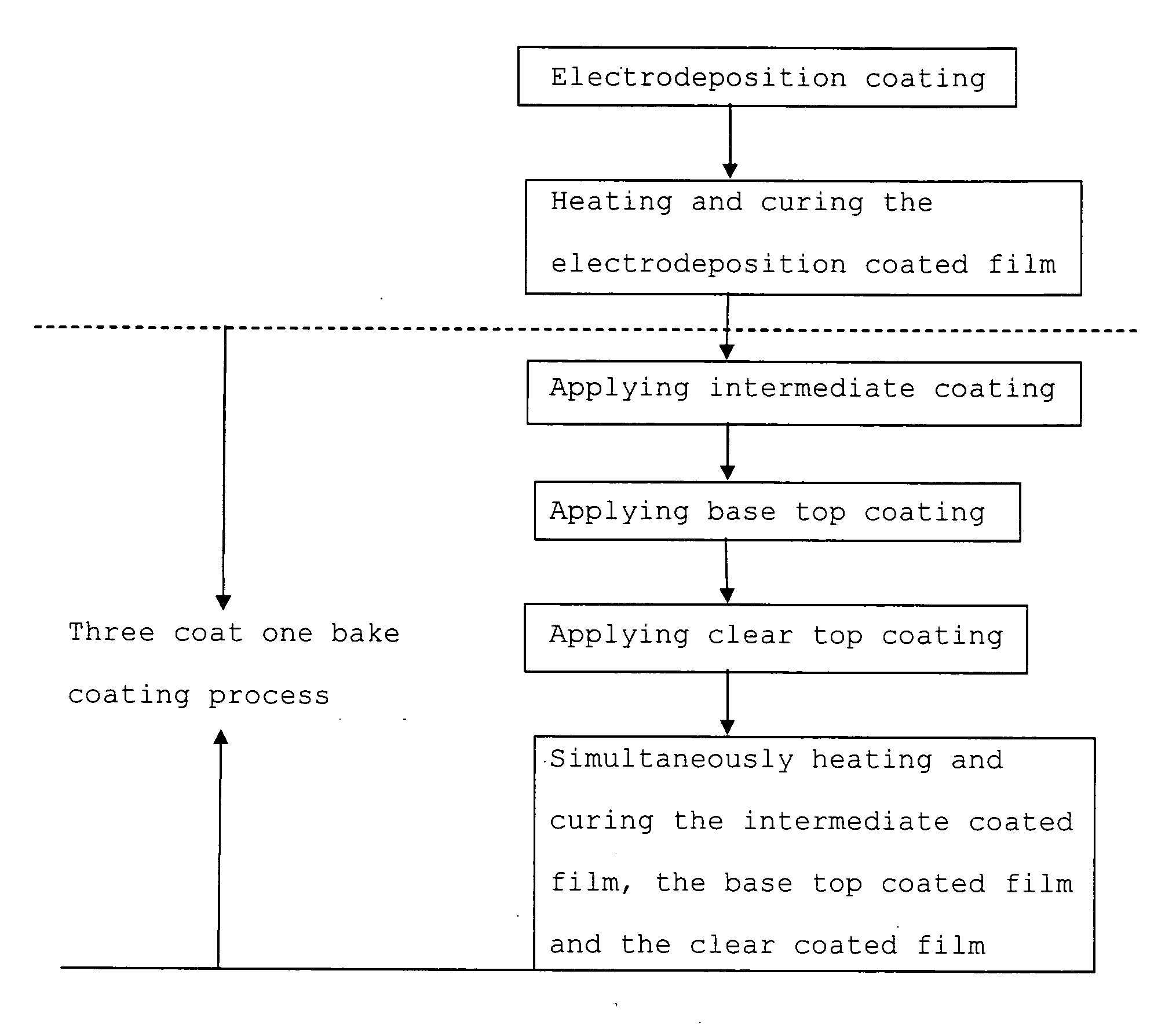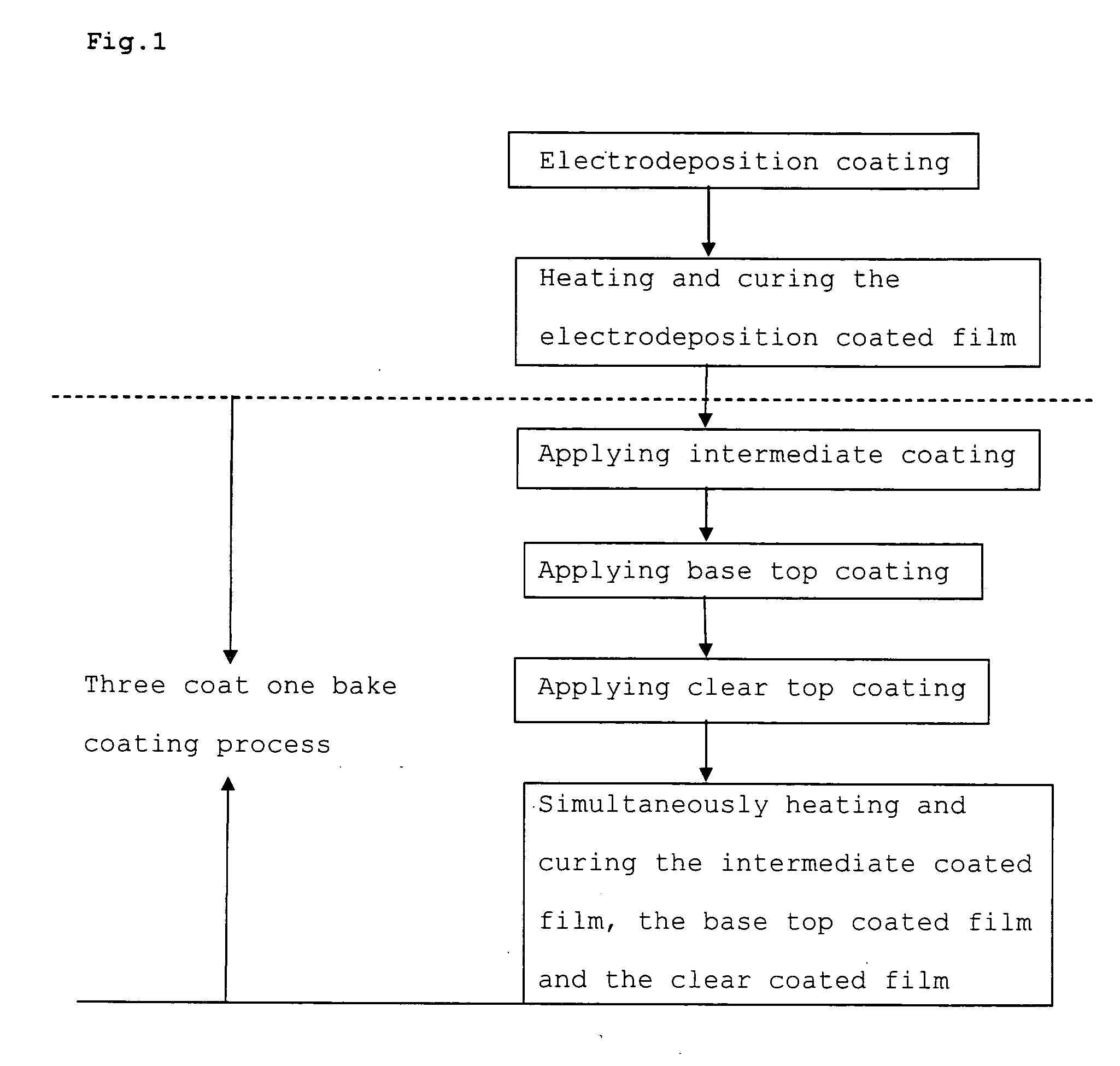Process for forming multi layered coated film and multi layered coated film
a coating film and multi-layer technology, applied in the field of multi-layer coating film formation, can solve the problems of degrading the finished appearance of the laminated coating film, and achieve the effects of reducing cost, good finished appearance, and saving energy
- Summary
- Abstract
- Description
- Claims
- Application Information
AI Technical Summary
Benefits of technology
Problems solved by technology
Method used
Image
Examples
preparation example 1
[0133] Preparation of Amine Modified Epoxy Resin
[0134] 92 parts of 2,4- / 2,6-tolylenediisocyanate (weight ratio=8 / 2), 95 parts of methyl isobutyl ketone (hereinafter, referred to as MIBK) and 0.5 part of dibutyltin dilaurate were loaded to a flask equipped with a stirrer, a cooling tube, a nitrogen introducing tube, a thermometer and a dropping funnel. 21 parts of methanol was added while stirring the reaction mixture. Starting at room temperature, the reaction mixture was allowed to rise to 60° C. by exothermic, the reaction was retained for 30 minutes, and 50 parts of ethylene glycol mono-2-ethylhexyl ether was dropped from the dropping funnel. Furthermore, 53 parts of bisphenol A-propylene oxide 5 mol adduct was added. The reaction was carried out mainly in the temperature range of 60 to 65° C., and continued until absorption based on an isocyanate group disappeared in IR spectrum measurement.
[0135] Next, 365 parts of epoxy resin of epoxy equivalent 188 synthesized from bispheno...
preparation example 2
[0137] Preparation of Block Polyisocyanate Curing Agent (1)
[0138] 1250 parts of diphenylmethane diisocyanate, 266.4 parts of MIBK were loaded to a reaction vessel, and 2.5 parts of dibutyltin dilaurate were added thereto after heating to 80° C. A solution of 226 parts of ε-caprolactam dissolved in 944 parts of butylcellsolve was dropped thereto at 80° C. over 2 hours. The reaction was retained at 100° C. for 4 hours, it was confirmed that absorption based on an isocyanate group disappeared in IR spectrum measurement, and left to be cooled. 336.1 parts of MIBK were added and thereby, a blocked isocyanate curing agent having a glass transition temperature of 0° C. was obtained.
preparation example 3
[0139] Preparation of Pigment Dispersing Resin
[0140] 222.0 parts of isophorone diisocyanate (hereinafter, referred to as IPDI) was loaded in a reaction vessel equipped with a stirrer, a cooling tube, a nitrogen introducing tube and a thermometer, and after diluted with 39.1 parts of MIBK, 0.2 part of dibutyltin dilaurate was added. Then, the reaction mixture was heated to 50° C., and 131.5 parts of 2-ethyl hexanol was dropped under dry nitrogen atmosphere over 2 hours with stirring. Reaction temperature was kept at 50° C. by cooling as necessary. As the result, 2-ethyl hexanol half blocked IPDI (resin solid content: 90.0%) was obtained.
[0141] 87.2 parts of dimethylethanolamine, 117.6 parts of 75% aqueous solution of lactic acid, and 39.2 parts of ethylene glycol monobutyl ether were added to a suitable reaction vessel, the reaction mixture was stirred at 65° C. for half an hour to prepare a quaternarizing agent.
[0142] Subsequently 710.0 parts of EPON 829 (bisphenol A type epoxy r...
PUM
| Property | Measurement | Unit |
|---|---|---|
| roughness | aaaaa | aaaaa |
| Ra | aaaaa | aaaaa |
| contact angle | aaaaa | aaaaa |
Abstract
Description
Claims
Application Information
 Login to View More
Login to View More - R&D
- Intellectual Property
- Life Sciences
- Materials
- Tech Scout
- Unparalleled Data Quality
- Higher Quality Content
- 60% Fewer Hallucinations
Browse by: Latest US Patents, China's latest patents, Technical Efficacy Thesaurus, Application Domain, Technology Topic, Popular Technical Reports.
© 2025 PatSnap. All rights reserved.Legal|Privacy policy|Modern Slavery Act Transparency Statement|Sitemap|About US| Contact US: help@patsnap.com



